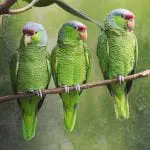Scientific Facts
| Common Name | Imperial Amazon |
| Scientific Name | Amazona imperialis |
| Lifespan | 50 – 60 Years |
| Size | 18.7 inches (48cm) |
| Body Mass | 22.75oz. – 31.5oz. (650 – 900grams) |
| Habitat | Rainforest canopy |
| Range | The Caribbean Island of Dominica |
Information & Physical Appearance
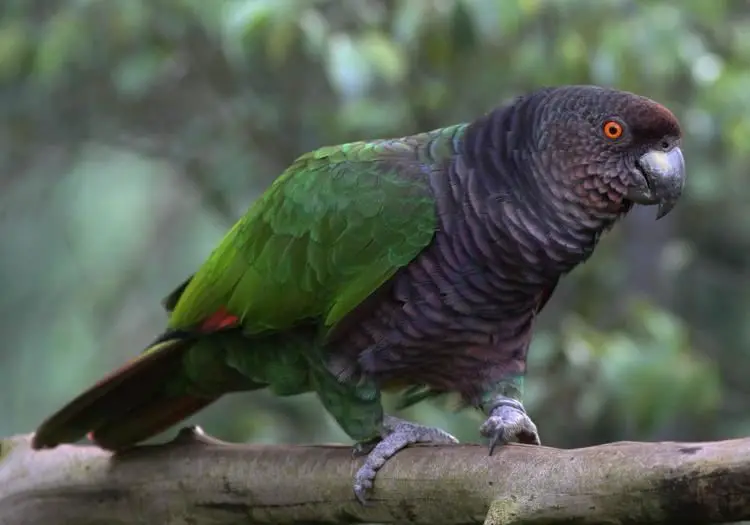
The Imperial Amazon (Amazona imperialis) belongs to the order Psittaciformes, the family Psittacidae.
Other common names:
- Imperial Parrot
- August Amazon
- August Parrot
- Sisserou
- Dominican Amazon
- Dominican Parrot
There are no recognized subspecies.
Adult males and females have identical plumage, displaying brown/purple coloring on the lores and forehead, with the purple nuances gradually becoming browner towards the cheeks and ear-coverts zones.
Ultimately, the upper parts, as well as the feathers, are dark green, while the chest is dark purple. Also, the feathers are edged in black.
The lower underparts exhibit olive/green coloration.
On the grown and on the neck, shades of burgundy/maroon are noticeable.
There is a dark brown eye-ring. The eye itself displays a mix of bright red and orange tones.
The bill is thick, hooked, and the coloring is horn/grey. The tail is short and square.
Even though Imperial Amazons are not sexually dimorphic, females are slightly smaller than males, weighing up to 23oz., while adult males weigh up to 32oz.
Juvenile
When it comes to juvenile appearance, it does not differ significantly from adults.
However, the eyes of immature Imperial Amazons are strictly brown, and there is a higher occurrence of green plumage, with the zone from the hindneck to the occiput being entirely green, while the zone behind the cheeks is only tinged with green. The face is brown/red on color.
Lifespan

Similarly to other Amazona species, Imperial Amazons are renowned for their longevity. Imperial parrots can live to 50 – 60 years on average.
Ecosystem & Habitat
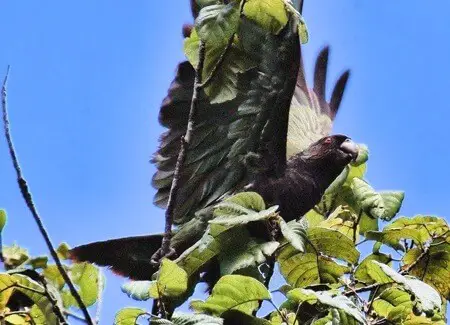
The Imperial Amazon Parrot is endemic to the Caribbean Island of Dominica, located in the Lesser Antilles.
Back in time, the Sisserou used to be widely distributed all over the island.
Nowadays, this species’ range is rather confined. Imperial parrots can be only found in the northern portions of Dominica, namely Mount Diablotin, and more specifically, in the upper Devil’s Valley (aka Picard River Valley), on the mountain’s northwest side.
Being a montane species, the Dominican Amazon is known to primarily live at an elevation ranging from 600 meters to 1300 meters.
Although occasionally, there are existing reports of Imperial Amazons observed at elevations as low as 150 to 300 meters.
It is mostly in the primary rainforest canopy where these parrots dwell. They will only descend from the rainforest canopy in response to a shortage of food supply.
Food & Diet
Imperial amazons in the wild are known to feed on a variety of flowers, nuts, seeds, berries, young shoots, and fruits.
Some of the most favored seeds and fruits include the ones obtained from Tapura antillana (bois cote),Clusia venosa (kaklin), Symphonia globulifera (mangle), and Dacryodes excelsa (gommier).
Also, Euterpe dominicana and E. Globosa (mountain palms) make a wonderful source of food, including not only the fruits/nuts but also the young shoots.
Fruits and seeds of Simarouba amara (bois blanc), Amanoa caribaea (carapite), Pouteria palladia (balate), Chimarrhis cymosa (bois riviere), Richeria grandis (bois bande), and Licania ternatensis (bois diable) are gladly consumed, too.
These birds usually feed twice a day – in the morning and in the evening.
Behavior
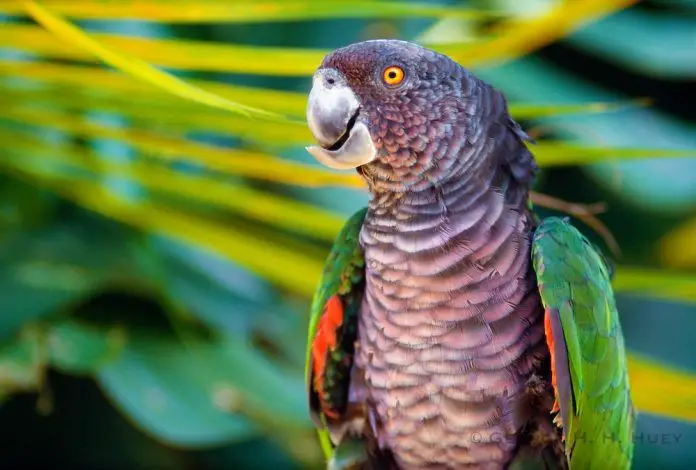
Imperial Amazons in the wild tend to be quite difficult to approach, and this has much to do with their shy personality.
These parrots are typically found in small flocks or in pairs. Sometimes, they may also form mixed flocks with another native parrot species endemic to Dominica, namely A. arausiaca (Red-Necked Amazon).
From July to November, Sisserous are especially unobtrusive.
These birds usually feed in the rainforest canopy. However, they have been also observed feeding close to the ground level.
As their plumage perfectly blends with foliage, they are extremely hard to see while feeding high in the treetops.
Imperial Amazons usually roost communally, with large gommier and chataignier trees being highly favored for roosting.
Imperial parrots are creatures of habit since they use the very same trees for roosting year after year.
The Dominican Amazon’s calls include a variety of trumpeting squawks, shrieks, shrill whistles, and nonetheless, harsh screeches, with none of the calls being song-like or melodic. While loud for most of the time, the calls can also be quite squeaky.
Reproduction
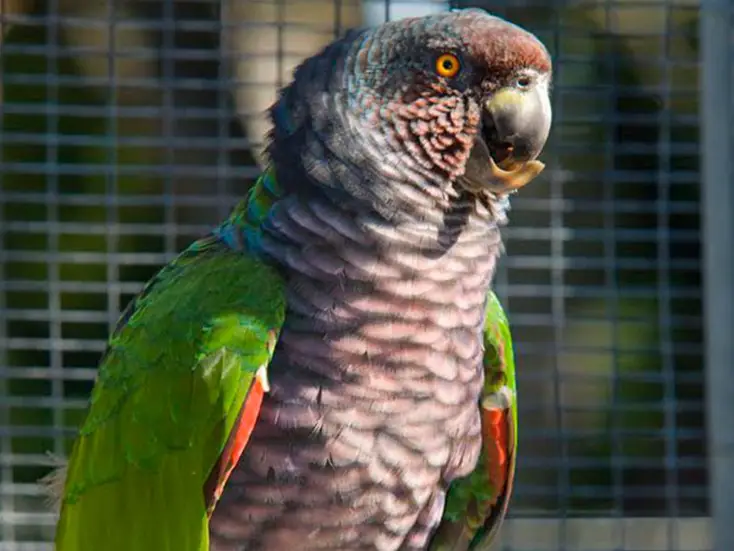
Imperial Amazons are strictly monogamous and are known to form strong, lifetime pairs. Both of the mates are to occupy, as well as defend their nesting territory throughout the year.
The way for pairs to make their presence known is achieved through display flights.
The pair may be most frequently absent from the nesting territory from early September through December.
The breeding season starts in February. It continues through June but reaches its peak in the period between March and May.
The breeding season coincides with the dry season on the Island of Dominica. Because of this, food is most abundant during this time of the year, being of great support to the proper raising and feeding of nestlings and fledglings.
Like other Amazon parrots, Imperial Amazons choose to nest in cavities, such as the cavities high in the trees’ trunks, e.g., Sloanea berteriana (chataignier) and gommier trees.
Unfortunately, despite the high abundance of food during the breeding season, the reproductive rate of Imperial Amazons is rather low.
Breeding pairs may only nest every other year. Usually, a pair is to fledge a single young from the small clutch of two eggs.
Both parents are to take care of the chicks.
Up-to-date, the age of first breeding remains unknown.
Survival Threats & Conservation
Due to its endemism on Dominica, as well as the severe destruction of habitat, the confined range, and low reproductive rates, the Imperial Amazon is considered a relict species.
Additionally, the inherent shyness of these parrots, in combination with their rugged home terrain, further makes it extremely challenging to estimate the populations remaining in the wild with certainty.
Ultimately, there are multiple threats to the survival of this species.
Ever since 1880, the species has declined rapidly because of habitat loss, hunting, and trapping. Furthermore, the 1979 hurricanes have also contributed to the population number dropping even lower, reaching an all-time low.
Major Survival Threats
- Habitat loss (due to logging for valuable timber, conversion to cropland, and charcoal production).
- Aerial spraying of banana crops (leading to blindness and poisoning).
- Hurricane David (1979), Hurricane Maria (2017).
- Illegal animal trading
- Ongoing consequences of climate change (severe weather, storms).
In addition to that, nesting cavity competition with owls and red-necked amazons contributes to creating a tough living environment for Imperial Amazons.
Also, there are several natural predators, namely broad-ringed hawks, rats, common opossums, and boa constrictors.
Back in 2012, there were only about 200 – 250 Imperial Amazons estimated to be left in the wild.
Nowadays, Amazona imperialis is listed as Critically Endangered on the IUCN Red List of Threatened Species. Based on the 2019 global assessment, there are as few as 1 – 49 mature individuals in the wild.
Tragically, the population trend is decreasing, even though there are conservation sited identified over the entire range, and a well-established action recovery plan.
Thanks to the RSCF (Rare Species Conservatory Foundation), the Wildlife and Parks Division, and Dominica’s Forestry, there are protected areas, such as the Central Forest Reserve and the Northern Forest Reserve.
There have been and still are many conservation efforts focused on the preservation of this unique bird species. Imperial Amazons are subject to recent awareness and education programs.
Also, Imperial Parrots are subject to trade controls, as they are listed on CITES’ Appendix I.
Availability – Where to Get an Imperial Amazon
Note that Imperial amazons are extremely rare in captivity. Because of their rare captive status, it is very difficult, if possible at all, to find these amazing, endangered parrots available for sale.
Interesting Facts
1. The Dominican Amazons’ bills are fashioned in such a way that they can easily move food around in their mouths by using their hinged mandibles and tongues.
2. Apart from their strong, specifically-shaped bills, Imperial Amazons are also “equipped” with powerful, muscular tongues.
3. It is suggested that the extinct or hypothetical A. violacea (the Guadeloupe Amazon) may actually be the same bird as the Imperial Parrot. Another theory suggests that the Imperial Amazon and the Guadeloupe Amazon may be very close relatives.
Based on the finding of a bone between Guadeloupe and Dominica (more precisely, in Marie-Galante), A. imperialis and A. violacea are suggested to have either inhabited or were traded between, every single one of the three islands all the way back in prehistoric times.
4. While being primarily found in mountain rainforests, Imperial Amazons do sometimes occupy elfin forests, too. Elfin forests are also known as pygmy forests or dwarf forests. An elfin forest is a very rare ecosystem.
5. It wasn’t before 2011 when the first successful captive breeding of Imperial Amazons was conducted by humans. It took 12 weeks for the young captive-bred individuals to fully develop, and they were found to closely resemble the imperial amazons found in the wild.
The successful captive breeding of this species is regarded as a huge step in terms of conservation since the Dominican Amazons have the lowest reproductive potential of all other Amazon parrots.
6. Imperial Amazons do not only mate for life but they are also extremely faithful to their mate. Only if one of the mates is to die may the other mate seek another partner. However, in many cases, the bird may actually grieve to death instead of finding a new partner to bond to.
How to Care for the Imperial Amazon
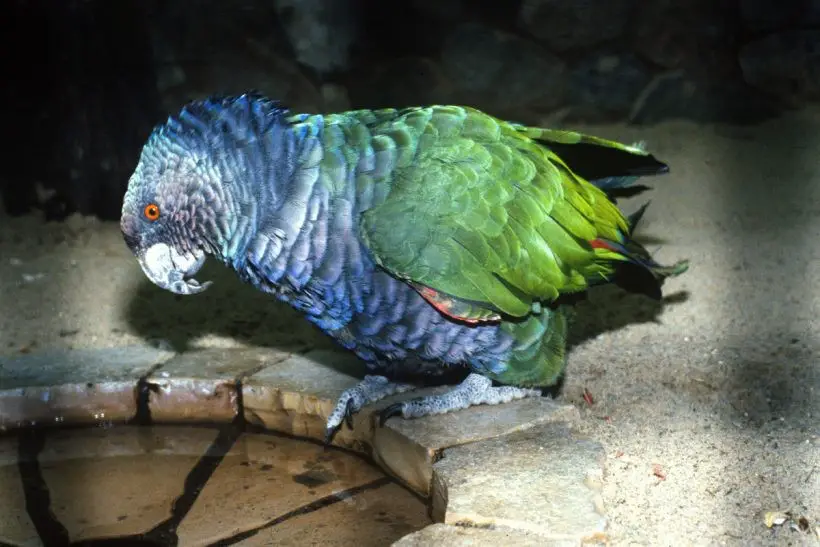
Preservation
One of the best ways to take care of the Imperial Amazon is to raise awareness. Share the incredible yet tragic story of this critically endangered parrot species with as many people as possible.
You may also choose to donate part of your time and/or money to support wildlife conservation organizations engaged with the preservation of Imperial Amazons.
Considering that climate change poses serious threats to the already confined and damaged habitat and native range of this endemic species, it is worth to spread awareness over the dire need of embracing an environmental-friendly mindset and lifestyle.
Housing
Similarly to other Amazon parrots, Imperial Amazons should only be housed in spacious, roomy enclosures.
An outside flight aviary measuring at least 32.8 x 9.8 x 8.2 ft.) should be provided. Alternatively, an indoor cage measuring at least 9.8 x 9.8 x 8.2 ft. should be utilized.
Note that Imperial Parrots require metal construction enclosures since these birds are “equipped” with exceptionally strong bills.
The enclosure should be further enriched with plenty of forage and chew items, e.g., heat sterilized pine cones, bird-safe wood (willow, elder, fir, pine), vegetable leather tanned toys, woodblock toys.
Overhead misters and/or shallow water bowls are a must as Imperial Amazons require regular bathing.
Diet
The captive diet for Imperial Amazons is not recorded, considering the species’ extreme rarity in captivity.
However, similar to other Amazona species, Imperial Parrots require a low-fat diet, compromised of about 30% fruits and veggies served daily, such as pomegranate, apples, cactus fruits, bananas, and pears, green peas, celery, carrots, beans, chickweed, dandelion, Swiss chard, fresh corn, and kale among others.
The major part of the diet should consist of spray millet and small seed mixtures that are low in fat. Provide complete kibble. Sunflower seeds and peanuts should be only offered in limited amounts.
FAQs
Where Do Imperial Amazons Live?
Imperial Amazons (Amazona imperialis) are endemic to the Caribbean Island of Dominica. It is only in Dominica where these birds are known to live in the wild.
How Big Do Dominican Amazons Get?
Adult male Imperial Amazons weigh up to 31.5 – 32oz., while adult females weigh up to 22.75oz. This species is considered large for its genus, measuring an average of 19 inches in length.
How Long Do Imperial Amazons Live?
Imperial Amazons usually live for about 50 -60 years.
What Do Imperial Amazon Parrots Eat?
In the wild, Imperial Amazon parrots eat a variety of fruits, blossoms, young shoots, nuts, seeds, and fruits. In captivity, they thrive on a diet similar for most other Amazona species and consisting of about 70% quality, low-fat seed mixes/millet and about 30% fresh fruits and vegetables.
Are Imperial Amazons Endangered with Extinction?
Yes, Imperial Amazons are endangered with extinction and are listed under the Critically Endangered category on the IUCN Red List of Threatened Species. As few as 1 – 49 mature individuals remain in the wild, and the population trend is estimated as decreasing.
Why Are Imperial Amazons Endangered?
The major threats to endanger the future survival of Imperial Amazons include habitat loss driven by human activity, such as clearing of land for agriculture and selective logging. Other survival threats include the severe weather and increasing number of storms, greatly accelerated by climate change, illegal trapping and hunting, and the low reproductive rates of this species.


